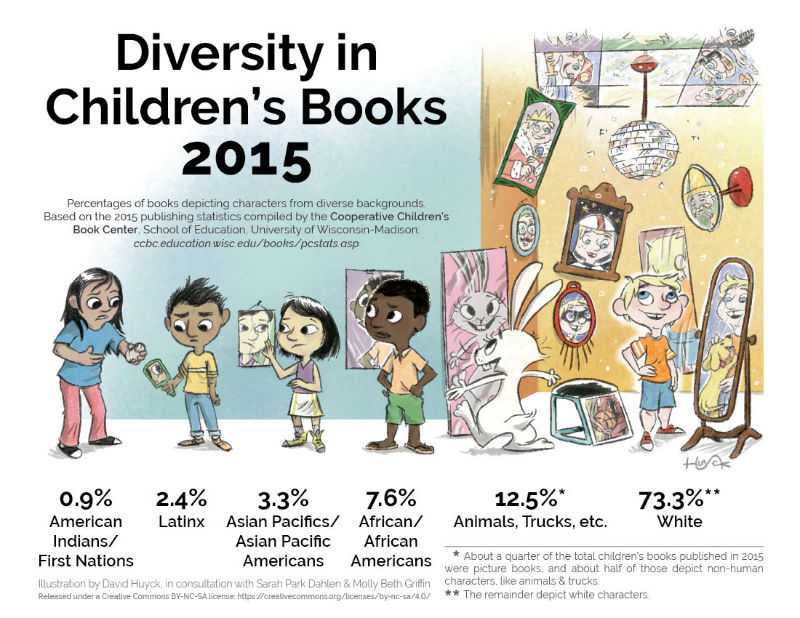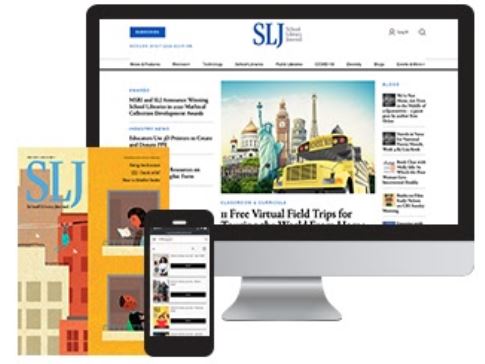An Updated Look at Diversity in Children's Books
Using numbers from the Cooperative Children's Book Center, this infographic—updated from 2015—illustrates representation in children's literature. The quantity of diverse books may have gone up, but that doesn't necessarily indicate accuracy and quality of titles.
An updated infographic on diversity in children's books has been released by Sarah Park Dahlen, an associate professor of MLIS at St. Catherine University in St. Paul, MN, and illustrator David Huyck.
While this 2018 version shows improvement in representation since 2015, the creators of the image added cracks in the mirrors to illustrate the continued misrepresentation of the underrepresented communities—the quantity of books may have gone up, but it isn't all good news as that doesn't necessarily indicate accuracy and quality in the titles.

"As with the 2015 infographic, we relied on the multicultural publishing statistics compiled by the librarians at the University of Wisconsin-Madison School of Education Cooperative Children’s Book Center ( CCBC ) that were 'about' particular populations: American Indian/First Nation, Latinx, African/African American, and Asian Pacific Islander/Asian Pacific American," Sarah Park Dahlen and David Huyck wrote on sarahpark.com. "One important distinction between the 2015 and 2018 infographics is that we made a deliberate decision to crack a section of the children’s mirrors to indicate what Debbie Reese calls 'funhouse mirrors' and Ebony Elizabeth Thomas calls 'distorted funhouse mirrors of the self.' Children’s literature continues to misrepresent underrepresented communities, and we wanted this infographic to show not just the low quantity of existing literature, but also the inaccuracy and uneven quality of some of those books....
"We hope that this infographic, along with Lee & Low’s Diversity Gap blog posts, Debbie Reese’s blog American Indians in Children’s Literature, Edith Campbell and Zetta Elliott’s blogs, Maya Christina Gonzalez’ “Children’s Books as a Radical Act” blog posts, Malinda Lo’s LGTBQ blog posts, We Need Diverse Books, Reading While White, Research on Diversity in Youth Literature, and other diversity initiatives, can help push forward important conversations and lead to real change in children’s literature publishing. We encourage you to study these and other sources to better understand the context in which these numbers exist."
|
Infographic citation: Huyck, David and Sarah Park Dahlen. (2019 June 19). Diversity in Children’s Books 2018. sarahpark.com blog. Created in consultation with Edith Campbell, Molly Beth Griffin, K. T. Horning, Debbie Reese, Ebony Elizabeth Thomas, and Madeline Tyner, with statistics compiled by the Cooperative Children’s Book Center, School of Education, University of Wisconsin-Madison: ccbc.education.wisc.edu/books/pcstats.asp. Retrieved from readingspark.wordpress.com/2019/06/19/picture-this-diversity-in-childrens-books-2018-infographic. |
For comparison, here is the 2015 infographic:

|
2015 Infographic citation : Huyck, David, Sarah Park Dahlen, Molly Beth Griffin. (2016 September 14). Diversity in Children’s Books 2015 infographic. sarahpark.com blog. Retrieved fromreadingspark.wordpress.com/2016/09/14/picture-this-reflecting-diversity-in-childrens-book-publishing
Statistics compiled by the Cooperative Children’s Book Center, School of Education, University of Wisconsin-Madison: ccbc.education.wisc.edu/books/pcstats.asp
Released for non-commercial use under a Creative Commons BY-NC-SA 4.0 license
|
RELATED
The job outlook in 2030: Librarians will be in demand
The job outlook in 2030: Librarians will be in demand
ALREADY A SUBSCRIBER? LOG IN
We are currently offering this content for free. Sign up now to activate your personal profile, where you can save articles for future viewing






Add Comment :-
Comment Policy:
Comment should not be empty !!!
Cressida Hanson
Has there been an updated infographic for 2020? Would love to see the (hopefully) progress.
Posted : Mar 24, 2021 03:32
Chamayne Green
Thank you for sharing this information. I share your site with other educators who support young children.
Posted : Nov 02, 2020 08:54
Star Perez
It is good that they are adding diverse ethnicity to these books, but as they are saying they are not representing well. I think a lot of work still needs to be done.
Posted : Sep 07, 2020 03:03
Melinda Henry
The statistics are discouraging. I realize that the numbers are going up, but so slowly. What I would like to know (due to population differences) what are the ratios of books of that particular culture to the US population of that culture? My next question would be are we not educating (Native American specifically) these children well enough, are we not telling them that they have a voice and that their voices matter well enough? I am curious.
Posted : Aug 18, 2020 04:51
Linda Garrett
I like the way you created a picture for you data. The mirror idea was brilliant! If a picture is worth a thousand words--you really made it clear how diversity in children's book still has a long, long way to go.
Posted : Apr 29, 2020 07:42
Desma Howell
I am glad to see that the numbers are getting better over time. Many are seeing improvements in the diversity in children literature. I am curious to see how those numbers have changed up to this point of the 20th century. I am sure diversity in children literature has increased tremendously.
Posted : Apr 28, 2020 12:09
Kurt Schmidt
It is important to know the diversity of the book purchasers, as well. You will get more of whatever sells. It comes down to priorities for both the publisher and the purchaser.
Posted : Jan 02, 2020 06:44
Yvette Bezuidenhout
It's great to see that things are improving but there's still a lot of work to do. Are these numbers a refelction of the people represented in the publishing industry? I think that self-publishing is one way to get more diversity into children's literature. Hopefully libraries will one day recognize that there are stacks of great books out there that haven't been born the traditional way.Posted : Jun 21, 2019 02:27
Jennifer Sobalvarro
I want to see what the numbers would be if you take away the "animals and other" category. Anyone have those percentages?Posted : Jun 21, 2019 11:42
Fact Check
CCBC has been tracking for years the many books its gets where main characters are non-white but not specific to an ethnic/racial group, but now elects NOT to include in their statistics: "Similarly we were once likely to count a book with a brown-skinned child, most often as African American, whereas now we track books with brown-skinned characters in which there are no apparent clues of the characters' specific race or ethnicity, but we do not count them as part of these statistics." https://ccbc.education.wisc.edu/books/pcstats.aspIn a 2017 interview with Hornbook, K.T. Horning said that this was a burgeoning number -- as much as 9% of all picture books, for example. (Also, about 9% of picture books at the time were multicultural.)Since CCBC has this information and the characters are non-white, it should be included in this infographic about non-white mirror books. Yes, the percentage of "white" books will decline as will the percent of books about things not people, but the infographic will be more accurate. SLJ, can you investigate?Posted : Jun 20, 2019 09:44